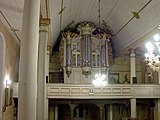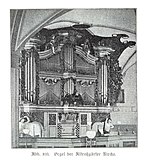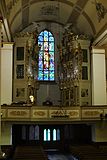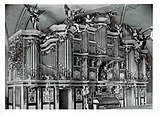Organ landscape East Prussia
The organ landscape of East Prussia includes organs and organ builders in the historical province of East Prussia from 1333 to 1945.
territory
The province of East Prussia emerged from the Duchy of Prussia and the Duchy of Warmia . In 1920 the Memel country came to Lithuania.
The northern part has formed the Russian Kaliningrad Oblast since 1945 , the southern part became part of the Polish Warmian-Masurian Voivodeship .
history
14th to 17th centuries
In 1333 an organ was mentioned for the first time in the Order of Prussia when planning the construction of the Königsberg Cathedral . In 1350 one was mentioned in Marienwerder , one in Frauenburg in 1380 and one in Bartenstein in 1393/95 ; parts of the latter were preserved until 1945.
In the 16th century Hans Hauck worked in Bartenstein and Braunsberg, "Jakob Orgelmacher", Jürgen Engelwein and Valentin Petsch in Königsberg. The brothers Michael, Joachim and Adrian Zickermann created organs between 1574 and 1623, among others for the Old Town Church in Königsberg, the Luther Church in Insterburg and the German Church in Memel . The builders of the new organ in Königsberg Cathedral from 1587 are unknown. With 59 registers and three manuals, this was one of the largest of its time.
In the 17th century Johann Kaul worked in Heiligenbeil, Christian Neumann in Wormditt, Joachim Thiele in Rastenburg Kętrzyn and David Trampp in Tilsit and Königsberg. Johann Werner from Elbing created a new building in Bartenstein (II / P, 37) in 1653, which was preserved until 1945. There was also a workshop in Mohrungen , which was taken over by Matthias Obuch in 1690. The oldest partially preserved organ in East Prussia is in Angerburg (Węgorzewo) by Joachim Thiele from 1680.
18th century


In 1698 Johann Josua Mosengel was appointed Prussian court organ builder. The East Prussian Schnitger created 37 new buildings, of which brochures in Heiligelinde and Passenheim have been preserved, as well as 28 conversions and repairs. His successor has been since 1731, his son Georg Sigismund Caspari , among other new buildings for the Koenigsberg castle church and castle church created.
In 1741 his cousin Adam Gottlob Casparini took over the workshop and built 43 organs in East Prussia and Lithuania, one of which is preserved in Vilnius and parts in Mühlhausen. His pupil Johann Preuß created 30 new buildings, of which the brochures in Insterburg (1766) and Königsberg-Löbenicht (1782) were preserved until 1945. Another student, Christoph Wilhelm Braveleit , built three new organs in Königsberg from 1790–1794.
19th and early 20th centuries
In the early 19th century, after the wars of 1807 and 1813, numerous organs had to be rebuilt or repaired. Pedals were also built into many instruments. The most important organ building families of this time were Scherweit and Johann Rohn . Well-known organ builders from abroad were Friedrich Ladegast with one instrument in Memel (1856/58) and Carl August Buchholz with three new buildings in East Prussia . Wilhelm Sauer from Frankfurt / Oder opened a branch in Königsberg in 1860 and built around 140 new organs in East and West Prussia by 1937.
From 1859 the Terletzki brothers from the West Prussian Elbing also worked in East Prussia, in 1871 Max Terletzki opened a company in Königsberg that produced around 130 new buildings and conversions by 1898. As his successor, Bruno Goebel created around 300 new structures and conversions by 1944 and was the formative East Prussian organ builder of his time. He built almost exclusively pneumatic action into new and existing instruments. Carl Novak built organs that were very inexpensive, but of limited quality. Karl Kemper from Lübeck opened a branch in Bartenstein around 1931 and, in addition to several new buildings, also carried out very professional restorations and conversions. His organ in the old town church in Königsberg from 1943 was the largest ever built in East Prussia with 71 registers. In the 19th and 20th centuries, most of the baroque organs were replaced or rebuilt, often to the detriment from a professional perspective.
After 1945
After 1945, many organs were at least partially preserved in the Polish part of East Prussia, despite war damage and looting. Some have been restored, others rebuilt or replaced. The largest historical organ is located in the Frauenburg Cathedral , the largest baroque organ in Pasłęk (Prussian Holland).
In the northern part of Russia all organs were completely lost in the following years. A few have been rebuilt since 1975. In 2007 the prospectus of the former Mosengel organ in Königsberg Cathedral was reconstructed and given a new work.
Organs
Warmian-Masurian Voivodeship
In the Polish part of East Prussia, numerous historical organs or organ brochures have been preserved. The most important is the Hildebrandt organ in Pasłęk (Prussian Holland) from 1717/19, which is almost completely preserved. The oldest surviving organ is in Węgorzewo (Angerburg) by Joachim Thiele from 1648. There are other baroque organs in Jelonki (Hirschfeld) and Wieliczki (Wielitzken). In addition, some historical brochures have been preserved, including those in the Frauenburg Cathedral. Many historical organs have been restored.
The information reflects the state of 1945 , and the current state of restored instruments. Instruments that are no longer available are in italics .
| place | building | image | builder | year | Manuals | register | Remarks |
|---|---|---|---|---|---|---|---|
| Angerburg (Węgorzewo) | St. Peter and Paul | Joachim Thiele | 1680 | III / P | 27 | oldest partially preserved organ in East Prussia, restored → organ | |
| Braunsberg (Braniewo) | St. Catherine | Bruno Goebel | 1909 | 42 | in Mosengel's baroque prospectus from 1726, destroyed in 1945 | ||
| Frauenburg (Frombork) | Dom | E. Kemper & Son | 1935 | III + I / P | 35 + 13 | Main and choir organ can be played from a common console via control cable , in Baroque prospectus by Daniel Nitrowski from 1685, 1970 expanded to IV + I / P / 49 + 13 by Kamiński → organ | |
| Grunau (Gronowo) | Ev. church | Johann Josua Mosengel | 1698/99 | I / P | 1866 pedal, destroyed in 1944/45 | ||
| Holy Linden tree (Święta Lipka) | Pilgrimage church |

|
Bruno Goebel | 1905 | II / P | 36 | in a baroque case with a multitude of movable angels by Mosengel . 2009 restoration by S. Sauer, Westf. |
| Heilsberg (Lidzbark) | Castle chapel | Mollin | 1971 | I. | 8th | Prospectus from 1760 preserved ( Johann Preuss ?), Almost completely looted in 1945, reconstruction in 1971 according to historical planning | |
| Hirschfeld (Jelonki) | Church Sacred Heart |

|
Andreas Hildebrandt | around 1725 | I. | 11 | receive |
| Landsberg (Górowo Iławskie) | Exaltation of the Cross Church | ? | 1895 or 1913 | in Baroque prospectus by Mosengel from 1701, demolished in 1974 | |||
| Leunenburg (Sątoczno) | Christ the King Church | Max Terletzki | 1886 | II / P | 23 | in the baroque prospectus, in which Casparini had already placed an organ in 1745. | |
| Mulhouse (Młynary) | Ev. church | Adam Gottlob Casparini | 1741-1744 | I / P | 21st | Wooden pipes and casings partially preserved, restored in 1971, not according to historical aspects | |
| Nikolaiken (Mikołajki) | Trinity Church | Johann Scherweit | 1842 | II / P | 19th | originally I / P, 15 ?, 1895 extension by Ferdinand Scherweit , 2007 restoration by Zych | |
| Passenheim (Pasym) | Ev. church | Carl Novak | 1902 | Baroque prospectus by Mosengel from 1705 preserved; including new building by Zych from 1998 (II / P / 23) | |||
| Prussian Holland (Pasłęk) | St. Bartholomew | Andreas Hildebrandt | 1717-1719 | III / P | 36 | largest preserved baroque organ in East Prussia, restored by Wegscheider in 2013 → organ | |
| Rastenburg (Kętrzyn) | former evangelical church | Johann Scherweit | 1838 | I / P | 11 | preserved, originally in Bäslack | |
| Wartenburg (Barczewo) | City Church of St. Anna | Johann Scherweit ? | 1834 | II / P | 25th | Built in 1608/16 in the monastery church by Adrian Zickermann , around 1630/80 new prospectus and probably reconstruction, in 1834 implementation in the town church and new building using some registers and expansion of the prospectus | |
| Wielitzken (Wieliczki) | Church , today Church of the Birth of Mary | George Adam Neppert | 1791 | II / P | 15th | originally in Schirwindt (I, 8), implemented in 1856, extension by Carl Novak in 1902/08 |
Kaliningrad Oblast
In the Russian part of East Prussia, all organs were completely destroyed after 1944. The last status is given, usually 1944.
| place | building | image | builder | year | Manuals | register | Remarks |
|---|---|---|---|---|---|---|---|
| Insterburg (Chernyachovsk) | Luther Church | Wilhelm Sauer | 1886 | in the baroque prospectus by Johann Preuss , rebuilt in the 1930s, destroyed after 1945 | |||
| Koenigsberg (Kaliningrad) | Altroßgärter Church |

|
Paul Walcker (W. Sauer) | 1913 | in Baroque prospectus by Casparini from 1747, destroyed in 1944/45 | ||
| Koenigsberg (Kaliningrad) | Old town church | E. Kemper & Son | 1943 | V / P | 71 | largest organ in East Prussia | |
| Koenigsberg (Kaliningrad) | Dom | P. Furtwängler & Hammer | 1928/29 | III / P | 64 | in Mosengel's baroque prospectus from 1721; 2007 Reconstruction of the prospectus with a new organ (V / P / 90) → organ | |
| Koenigsberg-Haberberg | Trinity Church | Wilhelm Sauer | 1902 | III / P | 50 | in Baroque prospectus by Casparini from 1753, destroyed in 1945 |
literature
-
Werner Renkewitz , Jan Janca : History of organ building in East and West Prussia from 1333 to 1944.
- Volume 1. Weidlich, Würzburg 1984.
- Volume II, 1. Mosengel, Caspari, Casparini. With Hermann Fischer. Pape Verlag, Berlin 2008. ISBN 978-3-921140-80-2
- Volume II, 2. From Johann Preuss to E. Kemper & Sohn, Lübeck, Bartenstein. Siebenquart, Cologne 2016.
- Jan Janca: East Prussia. In: Douglas E. Bush, Richard Kassel (eds.): The organ. To encyclopedia. Routledge, New York 2006. ISBN 0-415-94174-1 . Pp. 157-159
Web links
- Warmian-Masurian Voivodeship MusicamSacram, organs with dispositions (Polish)
- Organs in Königsberg with dispositions, links on sidebar
Individual evidence
- ^ Orgelbaukunst , II, 1, pp. 140f.
- ↑ Photo of the organ in Sątoczno ( Memento of the original from October 29, 2016 in the Internet Archive ) Info: The archive link was inserted automatically and has not yet been checked. Please check the original and archive link according to the instructions and then remove this notice. Parish (bottom)
- ^ Orgelbaukunst , II, 1, p. 316
- ↑ Mikołajki, Kościół ewangelicko-augsburski Świętej Trójcy MusicamSacram, organ with today's disposition, wrong builder information (Polish)
- ↑ ( page no longer available , search in web archives )
- ↑ research by Viktor Łyjak, 1999, see Organy w kościele pw. Św. Anny i św. Szczepana w Barczewie Leksykon kultury. Jan Janca wrote of 15 preserved registers from the 17th century with a strong lead content and II / P, 27, in Orgelbaukunst , II, 2, p. 720. About the Zickermann organ briefly in Organbaukunst , I, p. 44, 47
- ↑ Barczewo, kościół św. Anny Musicam Sacram, with disposition (Polish)







